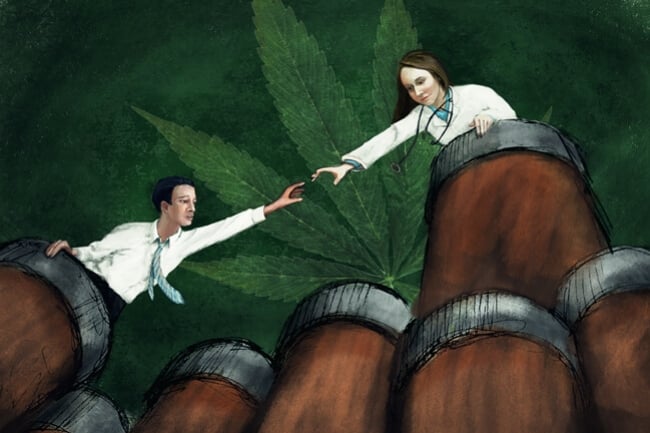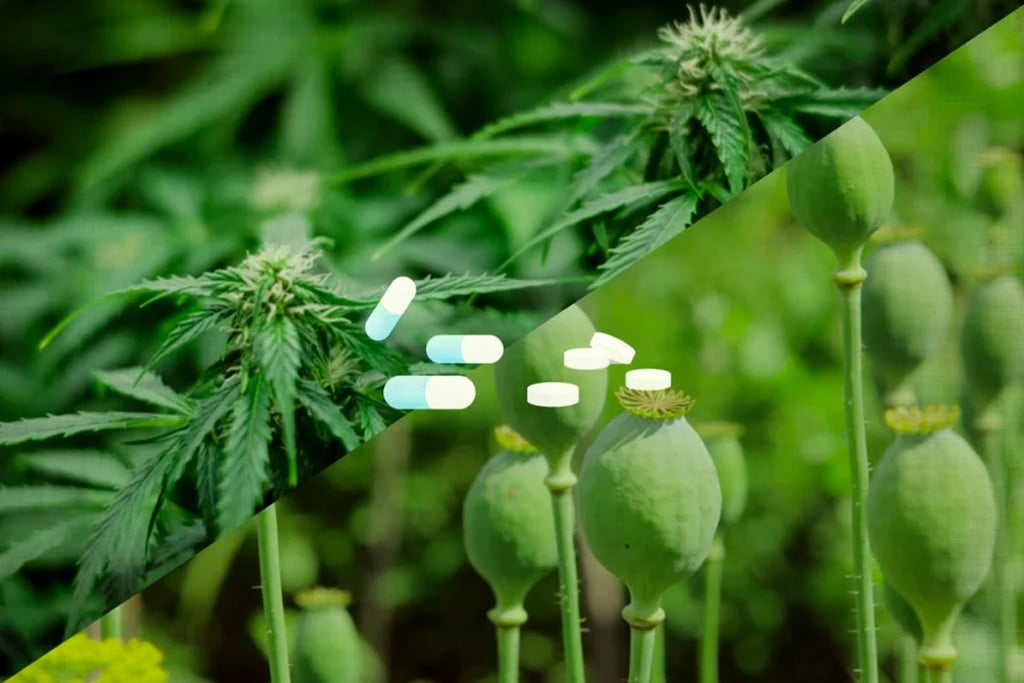.

Exploring the Relationship Between Cannabis and Back Pain
Humans have employed cannabis for thousands of years in an attempt to treat different forms of pain. In the modern era, back pain stands as one of the most common causes of pain, and many people self-medicate with cannabis to try to relieve their symptoms. But does weed actually help back pain? Find out what the research says.
Contents:
Does weed help with back pain? Chances are you've come across someone who told you it works for them. However, the research surrounding this topic remains early and inconclusive. Because this condition affects millions of people across the planet and current treatments are limited in their efficacy, researchers are keener than ever to find out the answer to this question.
Understanding Back Pain
Back pain holds the status of an epidemic; around 1 in 6 adults experience some kind of back pain in England alone. Alongside the prevalence of this condition, back pain is notoriously difficult to diagnose and treat. The traditional biomedical view of back pain postulates that sensations of pain stem from tissue damage in the form of a torn ligament, trapped nerve, or degenerating spinal disc.
However, some patients experience pain in the absence of tissue damage. Moreover, patients that show signs of tissue damage or dysfunction, such as a herniated disc, may experience little to no pain. These findings challenge the biomedical view and gave rise to a more nuanced model: the biopsychosocial view of back pain.
As the name suggests, this approach considers the biological, psychological, and sociological factors that all contribute to an individual’s perception and severity of pain. For example, some clinicians use an intervention known as pain neuroscience education (PNE) to address the psychosocial issues that can contribute to chronic back pain.
Conventional medications indicated to combat sensations of pain include over-the-counter products such as ibuprofen, certain antidepressants, and narcotics such as opioids. However, the side effects and abuse potential of these options often leave patients looking elsewhere; many choose to experiment with cannabis in an attempt to relieve their symptoms.
In what follows, we’ll begin by looking at the different types of back pain. Then, we’ll take a look at the role of the endocannabinoid system in back pain before examining what the research says about cannabis in this domain.
Common Causes and Types of Back Pain
Despite the complexity of some forms of back pain, other types are easily traced to an obvious cause and require relatively simple treatment. Below we break down back pain into two main categories: acute pain and chronic pain.
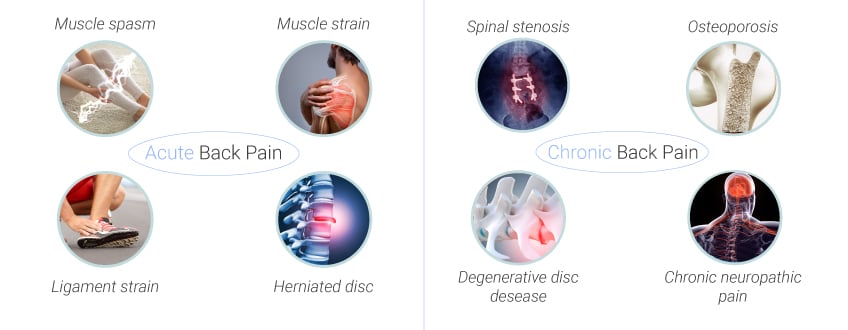
Acute Back Pain
Acute back pain refers to pain that comes on suddenly and doesn’t linger for long periods. This type of pain usually develops away from other physiological causes and instead stems from mechanical stress. Some of the major causes of acute back pain include:
- Muscle spasm: Muscle spasms can cause pain that ranges from a dull ache to a sharp stabbing sensation. They occur due to the involuntary contraction of muscle fibres and are often caused by the chronic underuse or overuse of the muscles involved.
- Muscle strain: Many different muscles are situated in the back; from the long stabilisers around the spine to the superficial prime movers that facilitate movement at the shoulder. A tear or strain in any of these muscles due to injury can cause short bouts of pain and loss of function.
- Ligament sprain: Whereas muscles enable us to move, ligaments limit movement around joints to keep them protected. Many ligaments contribute to the stability of the spine; smaller ligaments attach to individual vertebrae, whereas large ones span the entire length of the spine. Excessive contortion, flexion, extension, or rotation can cause a tear—or sprain—in a ligament and subsequent acute back pain.
- Herniated disc: Spinal discs are positioned in between each vertebra, where they act as shock absorbers. Each disc features a fibrous outer layer and a gelatinous inner portion. During disc herniation, the inner portion “slips” out through the fibrous tissue and sometimes makes contact with the spinal cord, resulting in pain. Herniation arises from both mechanical stress and age-related wear and tear. This form of injury often only takes 4–6 weeks to heal in many cases.
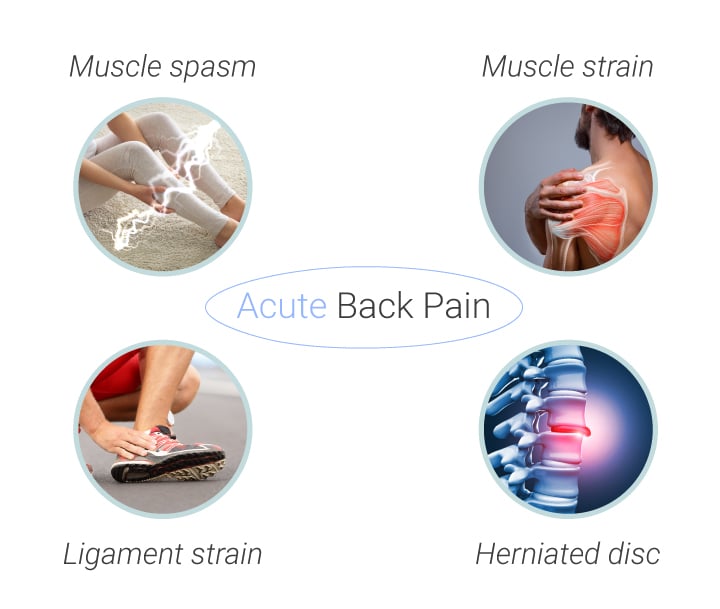
Chronic Back Pain
Unlike acute back pain, chronic back pain lingers for greater amounts of time. Many forms of chronic back pain have a biopsychosocial factor that can prolong recovery if not managed appropriately. Several conditions that can contribute to chronic back pain include:
- Spinal stenosis: Stenosis involves the narrowing of the spinal canal, which puts pressure on the spinal cord. The condition often occurs due to structural changes caused by osteoarthritis—the age-related degeneration of joint tissue.
- Osteoporosis: This condition stems from a reduction in bone density. Fewer minerals and less collagen within bones makes them more fragile and likely to fracture. Symptoms usually emerge when fractures occur. These structural changes can lead to conditions such as radiculopathy—an impingement that affects nerves at the root level.
- Degenerative disc disease: While herniated discs can resolve themselves quite quickly, degenerative disc disease involves the slow but inevitable degeneration of disc tissue. Discs begin to lose their water content and function, resulting in periods of severe pain, numbness in the extremities, and muscle weakness.
- Chronic neuropathic pain: This form of pain results from damage to nerve fibres and manifests as an intense burning sensation.
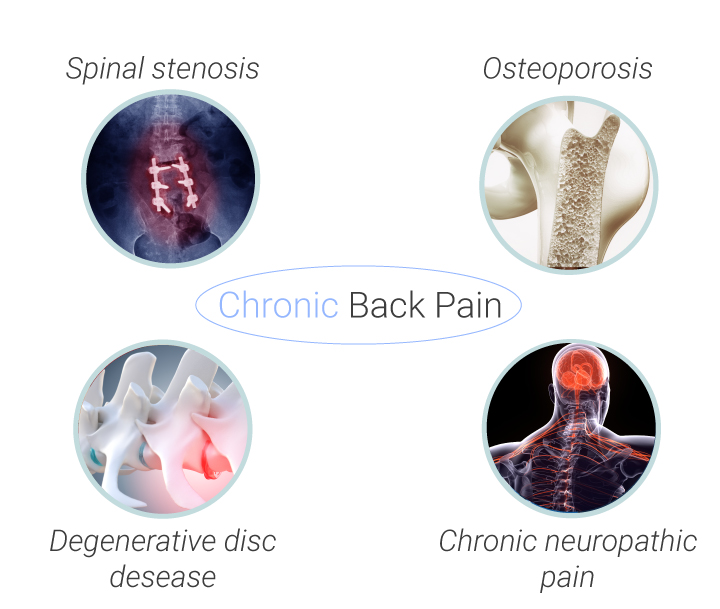
While certain conditions give rise to back pain, several psychosocial factors are also associated with chronic pain in general, including anxiety, depression, fear-avoidance, and post-traumatic stress disorder. Modifiable risk factors also increase the chances of experiencing chronic back pain, with obesity ranking as the most impactful.
How Back Pain Affects Daily Life
Both acute and chronic forms of back pain can take a toll on daily life. The painful sensations that they cause are enough to interrupt normal daily activities, and manifest in various forms, including aching, shooting, burning, and radiating pain. Over time, these symptoms begin to impact work ability, sexual function, and psychological state, potentially feeding into comorbidities of anxiety and depression, and generating the need for multidisciplinary care.
So, how can somebody get themselves out of this position? The range of available pharmaceuticals works for some people, but these medications rarely address the root cause of the pain. Exercise regimens and strength and conditioning also show great results, but don’t always lead to complete remission.
With that in mind, we’ll now examine the potential role that cannabis could play in the future of back pain treatment. To gain a good understanding of this, we first need to get to grips with the endocannabinoid system.
The Endocannabinoid System and Pain Signalling
The endocannabinoid system (ECS) controls many aspects of our physiology. Also known as the “universal regulator”, this network of chemical messengers, enzymes, and receptors keeps the human body in a state of homeostasis. These components are found throughout the central nervous system, immune system, digestive system, and even bone and connective tissues. No matter where they show up, they’re working in concert to make sure things are running smoothly.
In simple terms, the ECS consists of two main signalling molecules known as anandamide and 2-AG. These chemicals bind to the two major receptors, known as CB1 and CB2, to create changes within target cells. The sensation of pain arises as sensory neurons become depolarised and send an electrical impulse to the end of their axon (a branch-like structure at the end of a neuron). Here, the presynaptic neuron sends neurotransmitters over the synaptic cleft that activate receptors on the postsynaptic neuron; this activation generates another electrical impulse. This process continues until the impulse reaches the spine and registers in the brain as pain.
This type of neurotransmission, known as anterograde transmission, sends chemical signals in one direction. However, the ECS has a neat trick. It sends endocannabinoids in the opposite direction (retrograde transmission) to target receptors on the presynaptic neuron. This mechanism of action helps to transiently block neurotransmitter release and pain signalling, to a degree. But our own endocannabinoids only limit pain signals to a certain extent. However, it just so happens that plant-derived cannabinoids, such as THC, also interact with these same presynaptic receptors, giving rise to the possibility that THC could inhibit neurotransmitter firing in a similar way.
Pain only forms part of the picture when it comes to chronic back pain. Often, this uncomfortable sensation arises as a symptom of an underlying health condition. Because the ECS plays a regulatory role almost everywhere in the body, researchers are keen to find out if it could play a preventive or curative role in these root causes.
For example, studies have looked at the potential of the terpene (another type of compound found in cannabis) caryophyllene to remineralise bone tissue. Researchers are also looking to see if CBD provides any protection in models of degenerative disc disease. Adding to this, other studies are examining how cannabis and the ECS might help to tackle the psychosocial comorbidities of anxiety and depression, as well as modifiable risk factors such as obesity.
Marijuana for Back Pain: THC
The ECS shows some serious potential as a target in the treatment of back pain, and several cannabis-derived cannabinoids are known to latch onto ECS receptors, including THC. As the main psychoactive constituent in cannabis, THC underpins the high associated with marijuana. Countless anecdotes exist of people hitting joints or bongs and claiming that their pain went away, at least for a little while.
However, we need robust scientific evidence before we can say that THC has a positive impact on back pain. Fortunately, researchers are in the process of finding out the answers. One clinical review[1] discusses the available data from human studies, and reports that only moderate evidence exists so far that indicates cannabis for low-back pain.
However, the authors also examine recent epidemiological studies that obtained data from a population outside of controlled trial conditions. They found a reduction in the use of opioid pain medication in populations that take cannabis for low-back pain. Despite this, the amount of variables involved in epidemiological research makes these findings unreliable.
A more expansive clinical review examines cannabis for chronic pain[11] in general, and other medical and psychiatric issues. The data is partly derived from six trials involving 325 patients with chronic pain, and six trials involving 396 patients with neuropathic pain. Although mostly positive, these results require findings from further human trials to back them up.
A paper published in the European Journal of Pain supports these early findings[12]. The document details a nationwide register-based cohort study carried out in Denmark. The researchers questioned 1,817 patients that had received at least one prescription of cannabis-based medicine or medical cannabis for neuropathic pain. They then compared the patients' hospital visit frequency and reductions in conventional medication use against a control group.
Marijuana for Back Pain: CBD
CBD works differently from THC in the body. Because it doesn’t bind to the CB1 receptor as a strong agonist, it doesn’t cause the same psychoactive effect. However, CBD does work as an allosteric modulator[13] of the CB1 receptor, meaning it changes how THC binds to this site. CBD also impacts enzymes of the ECS.
Returning to the aforementioned anandamide—an endocannabinoid involved in pain signalling—CBD works to block the enzyme[14] responsible for breaking down this compound. In doing so, CBD could increase anandamide levels and maintain inhibition of pain neurotransmitters. However, human studies are needed to confirm this mechanism of action.
CB1 and CB2 receptors make up the “classical ECS”. However, a series of other receptor sites make up the expanded ECS, a system coined the “endocannabinoidome”. Some researchers argue that one of these sites, known as TRPV1, should hold the title of CB3 due to its notable interactions with endocannabinoids. CBD also interfaces with TRPV1[15]. This receptor plays a major role in inflammation and pain, making it a promising target regarding back pain.
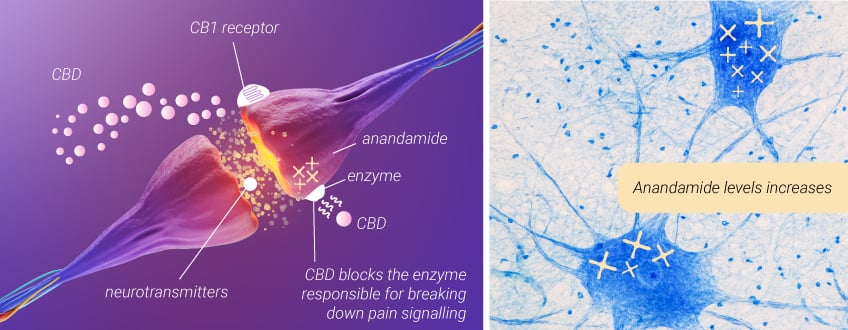
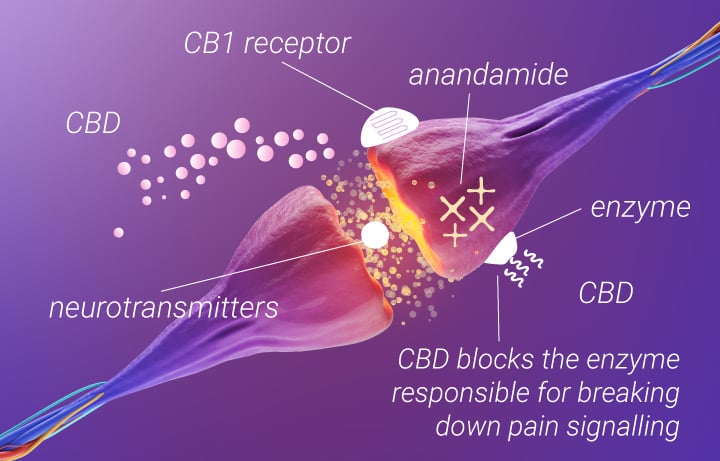
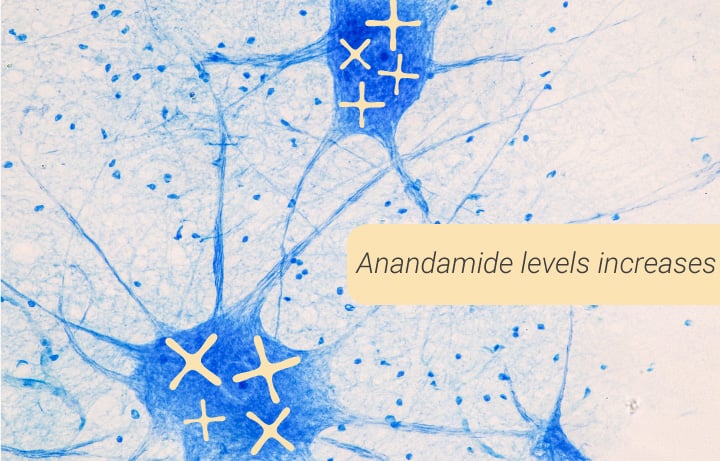
https://www.dovepress.com/cbd-effects-on-trpv1-signaling-pathways-in-cultured-drg-neurons-peer-reviewed-fulltext-article-JPR
Human trials are lacking when it comes to CBD and back pain. However, a case series[16] documents the potential efficacy of hemp-derived CBD in the form of a transdermal cream for both acute and chronic back pain. The cannabinoid seems to produce good results on the anecdotal level, but more rigorous trials are needed.
https://www.researchgate.net/profile/Jonathan-Eskander/publication/341491070Cannabidiol_CBD_as_a_treatment_of_acute_and_chronic_back_pain_A_case_series_and_literaturereview/links/5f6c0a28299bf1b53eedc4e3/Cannabidiol-CBD-as-a-treatment-of-acute-and-chronic-back-pain-A-case-series-and-literature-review.pdf
A study[18] published in the Journal of Pain Research tested an oromucosal spray containing both THC and CBD in chronic neuropathic pain. The researchers conclude that the concoction could have a role in managing this form of pain, but, again, future clinical trials are needed to elucidate its true efficacy.
The Last Word on Cannabis and Back Pain
Back pain remains a complex, nuanced, and prevalent health condition. The number of comorbidities and causes and the interplay of biopsychosocial factors make the condition difficult to diagnose and treat for clinicians. So far, the research surrounding the use of cannabis and its myriad constituents in cases of back pain remains inconclusive. A lack of clinical trials involving different cannabinoids for different forms of back pain means it’s too early to say if it works.
However, with laws surrounding the herb changing quickly, and more studies investigating treatments for back pain, it’s only a matter of time before we know the answer.
- Portsmouth Back Pain https://www.versusarthritis.org
- The efficacy of pain neuroscience education on musculoskeletal pain https://www.tandfonline.com
- Knowledge of psychosocial factors associated with low back pain amongst health science students: a scoping review | Chiropractic & Manual Therapies | Full Text https://chiromt.biomedcentral.com
- The Efficacy of Cannabis in Reducing Back Pain: A Systematic Review https://journals.sagepub.com
- β-Caryophyllene promotes osteoblastic mineralization, and suppresses osteoclastogenesis and adipogenesis in mouse bone marrow cultures in vitro - PMC https://www.ncbi.nlm.nih.gov
- Protective Effects of Cannabidiol on Lesion-Induced Intervertebral Disc Degeneration | PLOS ONE https://journals.plos.org
- The endocannabinoid system in guarding against fear, anxiety and stress - PMC https://www.ncbi.nlm.nih.gov
- Endocannabinoid system: Role in depression, reward and pain control (Review) - PMC https://www.ncbi.nlm.nih.gov
- Understanding the possible role of endocannabinoid system in obesity https://www.sciencedirect.com
- Cannabis and Pain: A Clinical Review - PMC https://www.ncbi.nlm.nih.gov
- Medical Marijuana for Treatment of Chronic Pain and Other Medical and Psychiatric Problems: A Clinical Review - PubMed https://pubmed.ncbi.nlm.nih.gov
- Cannabis-based medicines and medical cannabis for patients with neuropathic pain and other pain disorders https://onlinelibrary.wiley.com
- Cannabidiol is a negative allosteric modulator of the cannabinoid CB1 receptor - PMC https://www.ncbi.nlm.nih.gov
- Cannabidiol enhances anandamide signaling and alleviates psychotic symptoms of schizophrenia - PMC https://www.ncbi.nlm.nih.gov
- A Review of Scientific Evidence for THC:CBD Oromucosal Spray (Nabiximols) in the Management of Chronic Pain - PMC https://www.ncbi.nlm.nih.gov


























